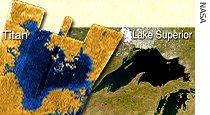-
(单词翻译:双击或拖选)
Washington
14 March 2007
A U.S. spacecraft studying Saturn1 has found evidence of large seas on its biggest moon, Titan. But if they are seas, they would not be filled with water. Instead, as VOA's David McAlary reports, they would be liquid beds of the hydrocarbon2 methane3, normally a flammable gas on the much warmer Earth.
 |
| A comparison view of a lake on Titan and Lake Superior |
In January, the orbiter's radar5 had viewed features the size of lakes on Saturn's moon, but Cassini scientist Stephen Wall of the Jet Propulsion Laboratory in California says the shapes just discovered are much larger.
"We have seen bodies of liquid that are big enough to be seas," he said. "One of them in particular is the size of a small sea on the Earth."
Titan is the solar system's second largest moon, 50 percent larger than Earth's moon. The body Wall mentions stretches nearly 1,100 kilometers to about half way down Titan's northern hemisphere. This makes it only slightly smaller than the Caspian Sea.
There is no definite proof that this and the other apparent seas contain liquid, and additional fly-overs will be necessary for confirmation6. But Wall says their dark appearance in radar indicates smoothness, and other properties point to the presence of liquids.
"We have now seen all of those things that you would typically associate with a body of water on the Earth - inlets and bays and channels and evidence of flow, drainage basins - all of those things," he said. "We know that it cannot be water on Titan because it is too cold, so we suspect that it is methane, which is right at the point where it can condense and evaporate."
Because methane is a major part of Titan's mostly nitrogen atmosphere, scientists have long believed that the moon has oceans filled with it . Titan is the only other body in the solar system known to have an active liquid cycle where the liquid evaporates from the surface and eventually recondenses as rainfall.
But the dense7 methane haze8 has hidden the view. Radar penetrates9 the haze and the earlier findings of probable lakes strengthened the belief in methane oceans. The new radar images add to the evidence.
As a result, Cassini team members will be re-pointing the spacecraft's radar during a fly-over in May so it can pass directly over the dark areas seen from farther away.
 收听单词发音
收听单词发音
1
Saturn

|
|
| n.农神,土星 | |
参考例句: |
|
|
|
2
hydrocarbon

|
|
| n.烃,碳氢化合物 | |
参考例句: |
|
|
|
3
methane

|
|
| n.甲烷,沼气 | |
参考例句: |
|
|
|
4
spotted

|
|
| adj.有斑点的,斑纹的,弄污了的 | |
参考例句: |
|
|
|
5
radar

|
|
| n.雷达,无线电探测器 | |
参考例句: |
|
|
|
6
confirmation

|
|
| n.证实,确认,批准 | |
参考例句: |
|
|
|
7
dense

|
|
| a.密集的,稠密的,浓密的;密度大的 | |
参考例句: |
|
|
|
8
haze

|
|
| n.霾,烟雾;懵懂,迷糊;vi.(over)变模糊 | |
参考例句: |
|
|
|
9
penetrates

|
|
| v.穿过( penetrate的第三人称单数 );刺入;了解;渗透 | |
参考例句: |
|
|
|















